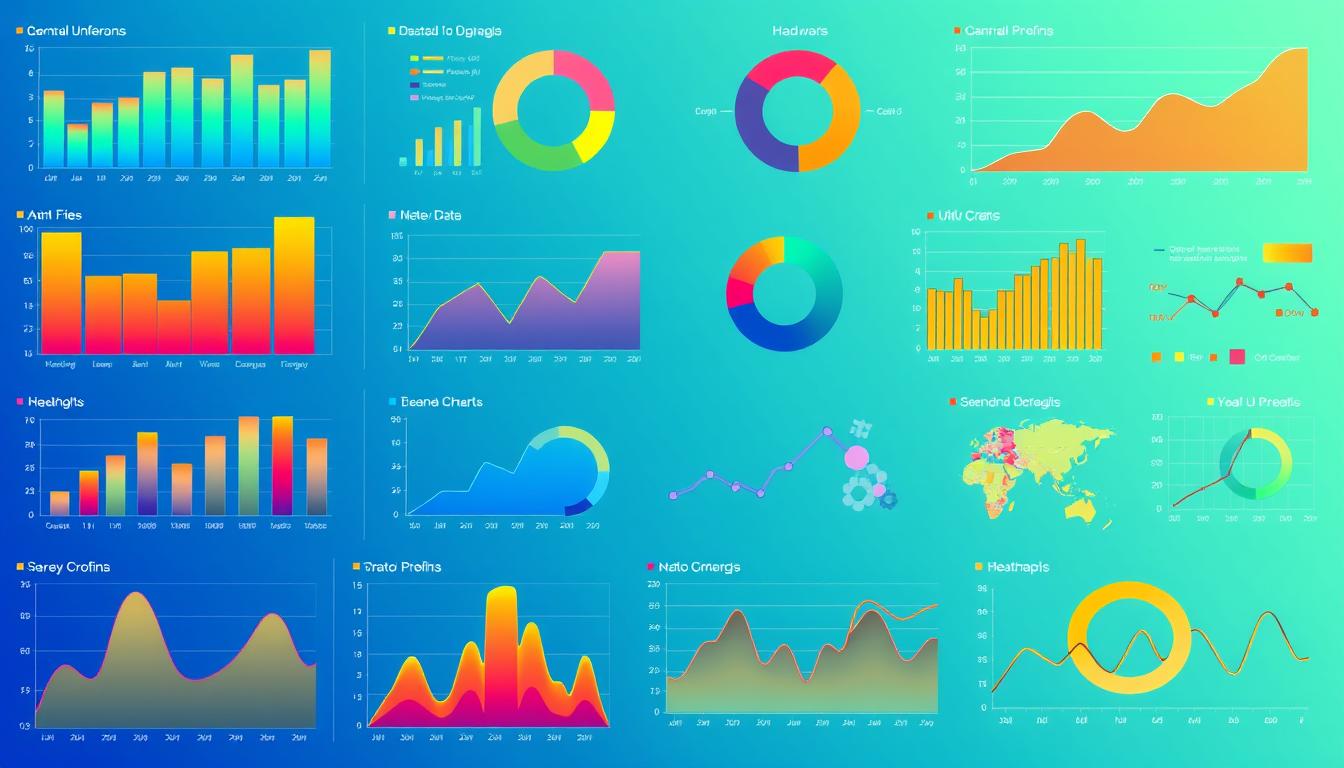Effective Management and Reporting Solutions for Business
In today's fast-paced world, the right management and reporting tools are key for UK businesses to succeed. These solutions make operations smoother and help make better decisions based on data. They also help companies stay ahead by using business intelligence and data analytics.

Key Takeaways
- Discover how effective management and reporting solutions can transform your business operations
- Understand the importance of data-driven decision-making in the modern business environment
- Learn about the core components of management systems and the role of data in driving business success
- Explore the benefits of implementing key performance indicators and data-centric strategies
- Gain insights into the essential tools and techniques for maximising business performance through analytics
Understanding Modern Business Management and Reporting
In today's fast world, good management and reporting are key for businesses to keep up and reach their targets. The rise of business intelligence tools and data analytics has changed how companies measure performance and make choices.
The Evolution of Business Intelligence Tools
Business intelligence tools have changed a lot over time. They've moved from simple spreadsheets to advanced data visualisation and predictive analytics. This has helped businesses understand their operations, customer habits, and market trends better. With data analytics, companies can make better, data-backed decisions, leading to better performance and growth.
Core Components of Management Systems
Good business management and reporting need a solid system. This system must have strong data collection and storage, fast data analysis, easy-to-use dashboards, and clear reporting channels. By combining these, businesses can use business intelligence to improve decision-making, streamline processes, and meet their goals.
The Role of Data in Modern Business
In today's digital world, data is crucial for businesses. Data analytics is the base for smart decisions, helping companies spot trends, find insights, and make choices that boost performance measurement and growth. Data helps businesses understand customers and improve operations, giving them a competitive edge.
"The ultimate competitive weapon is the knowledge that comes from data and information."
Key Performance Indicators: The Foundation of Business Success
In today's fast-paced business world, it's vital to track and improve key performance indicators (KPIs). KPIs are measurable signs that help businesses see how close they are to their goals. By focusing on the right KPIs, companies can understand their performance better and make smarter choices.
Effective KPI management starts with linking these metrics to the company's main goals. It's about picking the most important KPIs that show how well the business is doing in areas like money, operations, customer happiness, and staff engagement.
- Identify the most critical aspects of your business that require close monitoring and improvement.
- Establish clear, measurable, and attainable targets for each KPI to track progress effectively.
- Regularly review and analyse KPI data to identify trends, patterns, and areas for optimisation.
- Communicate KPI results to all stakeholders, fostering transparency and accountability throughout the organisation.
By using KPIs to guide business decisions, companies can make better choices. This leads to ongoing improvement and lasting success. In short, a solid base of key performance indicators is essential for any successful business.
"What gets measured gets managed." - Peter Drucker
Implementing Data-Driven Decision Making Processes
In today's fast-changing business world, making smart, data-driven choices is key. Companies that focus on data analysis and data-driven decision-making can better face challenges, spot chances, and grow sustainably.
Collecting and Analysing Business Data
The heart of data-driven decision-making is in collecting and analysing business data well. Companies need strong systems to get the right data from many places, like sales, customer opinions, and market trends. With top-notch data analysis, they can find key insights to guide their strategies and improve how they work.
Converting Data into Actionable Insights
Data's real strength is in turning it into useful insights. After getting and analysing data, companies must know how to use these insights. This means picking important business metrics, setting goals, and making sure data strategies fit with the company's aims.
Building a Data-Centric Culture
- Build a culture that values data-driven decision-making and promotes data literacy among staff.
- Invest in training to make sure team members can understand and use data well.
- Give employees the freedom to make choices based on data and help grow the data culture.
- Keep checking and improving how data is collected and analysed to stay effective.
By following these steps, companies can fully use their data and be ready for the future in a competitive, data-focused business world.
Essential Management and Reporting Tools for Business Growth
In today's fast-paced business world, the right tools are crucial for growth and success. These tools help streamline operations, improve decision-making, and keep businesses competitive.
Reporting tools are key to effective management. Microsoft Power BI, Tableau, and Google Data Studio give a clear view of performance. They combine data from various sources, making it easy to spot trends and make smart decisions.
Analytics solutions are also vital for growth. They help predict trends and spot risks early. Real-time monitoring tools let businesses track their performance closely, making quick, informed decisions.
| Reporting Tool | Key Features | Pricing |
|---|---|---|
| Microsoft Power BI |
|
Starts at £7.50 per user per month |
| Tableau |
|
Starts at £70 per user per month |
| Google Data Studio |
|
Free to use |
Using these advanced reporting tools, business intelligence platforms, and analytics solutions can open up new growth opportunities. They help improve efficiency and make better, data-driven choices.
Maximising Business Performance Through Analytics
In today's world, using analytics is key for better business performance. Advanced analytics, predictive analysis, and real-time monitoring help businesses make smart choices. They get insights that lead to better decisions and more efficient operations.
Advanced Analytics Techniques
Businesses have many tools to find hidden data patterns. These tools include prescriptive analytics and machine learning. They help make decisions based on data, improving performance and metrics.
Predictive Analysis Methods
Predictive analysis lets businesses see what's coming. It helps spot risks and solve problems early. This way, businesses stay ahead, use resources wisely, and grab new chances.
Real-time Monitoring Solutions
Real-time monitoring lets businesses track important signs quickly. This helps make fast, smart changes to strategies. It keeps businesses flexible and ready for changes.
Analytics is a game-changer for businesses. It opens the door to better performance, growth, and staying ahead in the market.

Creating Effective Business Dashboards
In today's fast-paced business world, making decisions based on data is key to success. Business dashboards play a crucial role here. They bring together important performance indicators and metrics. This lets everyone see how the business is doing quickly.
Creating a good business dashboard needs careful thought. It must look good and be easy to use. The aim is to make a dashboard that shows trends and helps make smart decisions fast.
Key Considerations for Crafting Impactful Dashboards
- Clarity and Simplicity: Don't overload the dashboard with too much info or complicated visuals. Keep it simple and focused on the most important dashboards and data visualisation elements.
- Targeted KPIs: Pick the reporting tools that really matter to users and the company's goals. Make sure the chosen KPIs give a clear but brief view of how the business is doing.
- Intuitive Navigation: Make the dashboard easy to navigate. This way, users can find and understand the info they need quickly.
- Dynamic Interactivity: Add features that let users dive deeper into the data. They should be able to filter and explore more easily.
- Timely Updates: Keep the dashboard up to date with the latest data. This gives stakeholders a real-time view of the business's performance.
By sticking to these guidelines, companies can make dashboards that are real decision-making tools. They help leaders make choices that lead to lasting growth and success.
"A well-designed dashboard is a game-changer, transforming complex data into a clear, actionable roadmap for business success."
Data Visualisation Techniques for Better Understanding
In the fast-paced world of business intelligence, showing complex data clearly is key. Data visualisation turns raw data into useful insights. This helps professionals make better decisions. By picking the right charts and design, companies can really understand their data.
Chart Selection and Design Principles
Choosing and designing charts is crucial for data visualisation. Think about the data, who you're showing it to, and what you want to say. Each chart type, like bar graphs or scatter plots, has its own role. The design, including colour and layout, must be clear and engaging.
Interactive Visualisation Tools
Today's business needs more than just static visuals. Interactive data visualisation tools are becoming key. These reporting tools let users explore the data in their own way. This makes the data more dynamic and personal.
Storytelling with Data
Data visualisation is not just about numbers; it's about telling a story. Storytelling with data combines visuals and data to share a message. By mastering this, professionals can turn complex data into stories that engage and inspire.

"The greatest value of a picture is when it forces us to notice what we never expected to see."
- John Tukey, Mathematician and Data Scientist
Streamlining Reporting Processes for Efficiency
In today's fast-paced business world, making reporting processes more efficient is key. It helps keep businesses ahead by making data more accurate and timely. This also means teams have more time for making important decisions.
Automating routine reporting tasks is a smart move. Using reporting tools that work well with current systems cuts down on manual work. This helps teams spend more time on analysing data, not just collecting it.
Standardising reports is also important. Having a set format for reports makes sure key metrics are tracked and shown clearly. This helps everyone make decisions based on solid data.
Integrating reporting tools with other business systems boosts efficiency even more. It automates data flow, reducing errors and making reports faster and more accurate.
| Reporting Tool | Key Features | Benefits |
|---|---|---|
| Power BI |
|
|
| Tableau |
|
|
By using these strategies, businesses can make their reporting better. This frees up resources and helps make decisions based on data. This leads to growth and success in the long run.
"Streamlined reporting processes are the foundation for informed, data-driven decision making in today's competitive business environment."
Integration of Business Intelligence Solutions
Businesses today need to integrate business intelligence (BI) solutions well. BI platforms help improve data analysis, reporting, and business performance. This is key to staying ahead in a data-driven world.
Choosing the Right BI Platform
Finding the right BI platform is vital. Companies must think about their specific needs, like data sources and user requirements. They should also consider scalability.
It's important to compare different BI tools. Look at their features and how they fit with your current tech setup. This helps make a choice that supports your future goals.
Implementation Strategies
- Make a detailed plan for the project. Include a timeline, who will work on it, and key milestones.
- Make sure data from different sources can be easily combined. This gives a clear view of how the business is doing.
- Put in place strong data management rules. This keeps data quality, security, and compliance high during the integration.
- Work with different teams to make sure the BI solution meets everyone's needs.
Training and Adoption
Getting BI to work well needs good training and adoption. Create training that teaches users how to use the BI tools well. Show how the BI solution helps the business and offer support to make the transition smooth.

Choosing, implementing, and adopting BI solutions wisely can unlock your data's full potential. This leads to better decision-making, business intelligence, and growth.
Performance Measurement and Metrics Analysis
In today's fast-changing business world, performance measurement and metrics analysis are key. They help drive growth and meet strategic goals. By setting up good measurement systems and looking at performance indicators, companies can learn a lot. This knowledge helps them make better decisions and reach their goals.
Creating a strong performance measurement framework is essential. It starts with picking the right key performance indicators (KPIs) that match your business goals. Then, you track and analyse these metrics to see how you're doing and where you can get better.
- Choose performance indicators that show how well you're doing, like customer happiness, sales, efficiency, and money matters.
- Use data to keep an eye on things and make smart choices based on facts.
- Keep checking and updating your metrics to make sure they still fit with your business and the market.
Using performance measurement and analytics helps you find important insights. It shows where you can improve and helps you make smart changes. A focus on data can lead to growth, better ways of doing things, and a strong edge over competitors.
| Key Performance Indicator | Description | Benchmark |
|---|---|---|
| Customer Satisfaction | Measures how happy your customers are with what you offer | 90% customer satisfaction rating |
| Sales Growth | Looks at how much more you're selling each year | 15% annual sales growth |
| Operational Efficiency | Checks how well and cheaply you run your business | 85% operational efficiency |
| Financial Performance | Looks at your business's money health and profit | 20% profit margin |
By focusing on data in performance measurement and analytics, you can really make your business shine. This leads to lasting growth and success.
Best Practices for Business Reporting
Effective business reporting is key for making decisions based on data. To get the most out of your reports, follow best practices. These include making reports clear, easy to access, and useful for action.
Consider the structure and format of your reports. Use a clear structure with an executive summary, key business metrics, detailed analysis, and action plans. Use headings, bullet points, and data visualisations to make it easy to read.
Think about how often and to whom you should send reports. Some companies prefer monthly or quarterly updates. Tailor report distribution to meet the needs of different teams or decision-makers.
Handling sensitive data means following strict security and compliance rules. Use strong access controls, encrypt sensitive info, and follow industry and company policies. This keeps your data safe and shows you care about responsible data handling.
By following these best practices, you can improve the quality and impact of your reports. This leads to better decision-making in your organisation.
Overcoming Common Reporting Challenges
In today's fast-paced business world, reporting can be tough. It's about making sure data is right and reports match up with goals. These challenges can block good decision-making and slow down growth.
Data quality is a big problem. Bad data can lead to wrong conclusions and poor choices. To fix this, companies need strong data rules and cleaning methods. This makes sure their reporting tools and data analysis are trustworthy.
Another big challenge is information overload. With so much business intelligence data, it's hard to find useful insights. Using clear data visual tools like dashboards and charts can help. They make complex data easy to understand and spot trends.
| Common Reporting Challenges | Suggested Solutions |
|---|---|
| Data Quality Issues | Implement robust data governance strategies, including data validation and cleansing processes. |
| Information Overload | Utilise effective data visualisation techniques, such as interactive dashboards and intuitive charts. |
| Aligning Reports with Organisational Goals | Collaborate with stakeholders to ensure reports are tailored to meet specific business needs and objectives. |
Aligning reports with goals is also a big challenge. Companies must link their reports and metrics to their main goals. This way, they can make decisions based on data that helps them grow. Working with key people to understand their needs helps create reports that are useful and can be acted upon.
By tackling these common reporting issues, companies can use reporting tools, data analysis, and business intelligence to make better decisions. This helps them reach their strategic goals.
Future Trends in Business Analytics and Reporting
Business intelligence and data analytics are changing fast. The future of management and reporting will see big changes. Advances in artificial intelligence (AI) and machine learning (ML) will change how we measure performance and make decisions.
Predictive analytics are becoming more popular. AI and ML help organisations understand future trends and customer behaviour. This lets them make better, more strategic choices. They can spot challenges and opportunities early, improving their performance.
Real-time data monitoring is also on the rise. Businesses can now quickly access and analyse data. This lets them adapt fast to market changes. Having real-time insights can be a big advantage, helping them stay ahead.
Business reports will soon be more engaging and interactive. New data visualisation tools will make complex data easier to understand. Interactive dashboards and reports will help organisations share their performance better.
As business analytics evolve, those who adopt new trends will thrive. They will grow, improve, and stay competitive. The future looks bright for those who embrace these changes.
"The future of business analytics lies in the seamless integration of AI, predictive modelling, and real-time data monitoring – empowering organisations to make more informed, agile, and impactful decisions."
Conclusion
In this article, we've looked at how good management and reporting are key to business success. We've seen how business intelligence tools have evolved and how they help make decisions based on data. This shows the importance of modern management systems.
Using business intelligence and key performance indicators is vital for better business performance. Advanced analytics and data visualisation help organisations understand their data better. This leads to smarter decisions and growth.
Looking ahead, business analytics and reporting tools will keep improving. This will change how companies manage and report. By following these trends, businesses can stay competitive and improve their operations in a data-driven world.
FAQ
What are the key components of an effective management and reporting system?
A good management and reporting system has several key parts. These include business intelligence tools and KPIs for measuring performance. It also needs data analytics and easy-to-use reporting interfaces. Together, they help make data-driven decisions.
How can businesses leverage data analytics to improve their performance?
Businesses can use advanced analytics to get insights from their data. They can use predictive analysis and real-time monitoring. This helps spot trends and make decisions that boost performance.
What are the best practices for creating effective business dashboards?
Creating great business dashboards involves a few key steps. First, choose the right chart types and use simple layouts. Add interactive features so people can easily see important metrics.
How can businesses overcome common reporting challenges?
Businesses can tackle reporting issues by focusing on data quality and reducing information overload. They should also align reports with company goals. This can be done through good data governance, automated reporting, and a data-focused culture.
What are the future trends in business analytics and reporting?
The future of business analytics and reporting looks bright. Advances in AI, machine learning, and predictive analytics will be key. These will help businesses get accurate, timely insights and make better decisions for growth.
Call Us
Our service area
- Central London
- North London
- South London
- East London
- West London
- Surrey
- Kent
- Essex
- Hertfordshire
- Buckinghamshire
